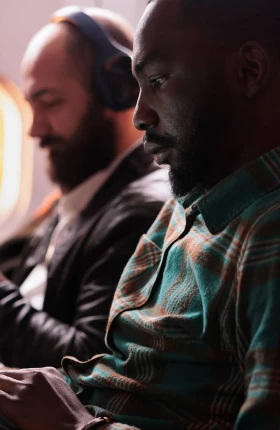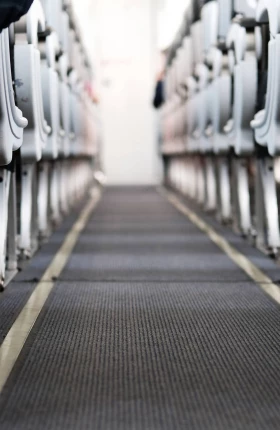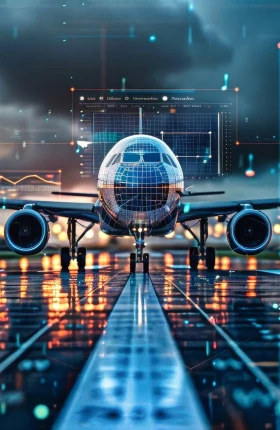This article is part of a series developed by BCG in collaboration with the International Air Transport Association on the airline industry’s transition to modern retailing. The four previous articles are “Charting the Future of Airline Retailing,” “Reshaping the Airline Organization for the Future of Retail,” “Successful Airline Retailing Requires Industry Partnership,” and “Can Airlines Accelerate the Transition to Modern Retailing?”
Modern airline retailing—based on 100% legacy-free offers and orders—represents a unique opportunity to improve the customer experience and create more value. To capture this potential, most airlines have so far focused on the technological and commercial sides of the transformation, by investing in digital channels and commercial solutions. Those are important, but they are not enough. Airlines also need to develop new organizational models and ways of working.
For the past five years, BCG has collaborated with the International Air Transport Association on research and analysis to accelerate the industry’s transition to modern airline retailing. For this year’s study, we spoke with more than 50 senior leaders in order to identify the constraints limiting the transition, focusing specifically on organizational models. Our analysis pointed to several factors:
- Many airlines have deeply entrenched structures and processes, making it difficult to adopt new behaviors and ways of working.
- Airlines need to reinforce the key skills that modern retailing demands, such as data analytics, dynamic product management, merchandizing, and omnichannel distribution.
- Making the shift to modern retailing will require truly cohesive ways of working across commercial teams, especially revenue management, e-commerce, and marketing.
Airlines are aware of modern retailing’s potential. (See “The Benefits of Modern Airline Retailing.”) To make faster progress, they should focus on a number of essential capabilities and redesign their organizations to support those capabilities through cross-functional governance, reshaped roles and accountabilities, clear goals and incentives, and strong leadership in building a culture of innovation.
The Benefits of Modern Airline Retailing
- Offers will get richer and more customized. The flight seat is bundled with an increasing number of products and services—provided by both the airline (preboarding, baggage check) and external partners (hotels, car rentals, travel experiences)—which are created and priced in real time based on the individual shopping request.
- Distribution will be more cost efficient and truly omnichannel. Thanks to digital channels and the International Air Transport Association’s New Distribution Capability standard, airlines can provide customers in indirect channels with richer content (in line with the content in their own channels), while managing distribution costs more efficiently.
- Customer interactions will be more frequent and relevant. Airlines will have real-time passenger status updates and can send updated offers at every touchpoint in the customer journey.
- New payment methods will be available. Customers will be empowered to pay however they like—just as they can with any e-commerce retailer—securely and with airlines having a clear sense of the financial impact of various options (factoring in cost, time to cash, and security). Payments will become a core enabler of a seamless customer experience.
- Orders will be fully integrated. Customer-facing processes will mesh with internal accounting and delivery processes. Airlines will have a single source of truth for every customer order—from initial offer to final settlement—streamlining key processes.
Seven Essential Capabilities
While most organizations already possess—to some degree—some of the capabilities needed to operate in a world of legacy-free offers and orders, they will need to elevate them into more cohesive disciplines, possibly managed by new, clearly defined departments. Effectively, modern retailing requires airlines to recast the organization around seven areas.
- Product management establishes clear ownership over the end-to-end portfolio of products and services—air and non-air ancillaries, internal and third-party offerings—and ensures their availability to customers.
- Offer optimization acts as the airline’s real-time “commercial brain,” combining demand signals, context, knowledge about the customer, and inventory constraints to generate the right product and price combination for every shopping request.
- Distribution and channel strategy drives demand and conversion by steering channel mix through a coherent go-to-market strategy across markets and customer segments.
- Payments management transforms payments from a cost center into a strategic profit lever, offering new ways for customers to pay, optimizing the cost of acceptance across different payment modes, accelerating time to cash, reducing fraud, and improving checkout conversion.
- Order management provides a single, authoritative record of customer orders—linking offer creation to delivery and settlement—that can more easily be used by the airline to enhance the customer experience.
- Delivery ensures that every product and service purchased is delivered on time and in full, including during travel disruptions.
- Customer journey management champions the end-to-end customer experience, defining the target journey, setting cross-functional standards, and ensuring that every interaction—before the trip, during the trip, and after the trip—is personalized, reinforces loyalty, and increases the customer’s lifetime value.
Together, these seven capabilities form an end-to-end engine for modern retailing. They define what can be sold and how, so that airlines can pull demand through the right channels, offer multiple secure payment options, anchor revenue and profitability accounting, and fulfill delivery to customers, all while consistently and proactively managing each step of the customer journey.
Many airlines have some of these elements in place today, but almost none combines all seven in an integrated manner. Instead, individual areas sit in disconnected silos—some duplicated, others missing entirely—creating unclear accountabilities, slow handoffs, and gaps that limit the airline’s ability to deliver a better overall experience. To capture the full value from offers and orders, airlines must develop and integrate these capabilities through specific organizational changes.
Stay ahead with BCG insights on travel and tourism
Strengthen Cross-Functional Governance
Modern retailing blurs the old boundaries between revenue management, marketing, distribution, digital, operations, and finance, requiring tighter orchestration across departments. In our conversations, executives repeatedly emphasized that the new approach entails fundamentally new domains that require a distinct approach to ownership and collaboration.
More Cross-Functional Teams. Several airline executives favored creating cross-functional units dedicated to the seven priority capabilities rather than standalone departments or loose dotted-line reports. For example, product management, distribution and channel strategy, and delivery could be handled by teams that sit in different departments but interact regularly.
Specialized Capabilities. Despite the need to be more cross-functional, the executives we spoke with said that some of the seven capabilities—notably, offer optimization and order management—should be run by dedicated teams. In fact, they still see value in a standalone offer optimization unit to oversee pricing science and inventory controls (as revenue management teams have done for decades).
Dedicated Focus on the Customer Experience. Executives see value in creating a standalone customer journey management unit to strengthen the decision-making power of a role that in most organizations is typically fragmented and weak.
Shared Accountability Across the C-Suite. Most executives argue that stewardship of the retailing agenda should sit with a coalition of C-level and department heads, not a lone C-level leader (such as a “chief of modern retailing”) sitting apart from day-to-day operations. The CFO needs to be involved to oversee money flows and accounting changes, the CCO to oversee products and revenue, the COO to oversee operations and airport experience, and the CIO to oversee IT platforms.
Early movers are finding ways to dismantle organizational silos. Although these are only at an early stage of development, they show some potential paths that others could take:
- Agile, Cross-Functional Teams. Leading carriers form squads that unite revenue managers, marketers, data scientists, and IT specialists to deliver specific initiatives in their modern-retailing roadmap.
- The “Offer Franchise.” Some airlines are merging revenue management and ancillary services—and sometimes even in-sourcing expertise from the scheduling team (to better match product offerings, such as onboard Wi-Fi, to aircraft types)—into a single offer group reporting to the CCO.
- Unified Channel Management. Some are also merging direct and indirect channels into a unified distribution function that balances reach, cost to serve, customer acquisition, and content strategy across all channels.
- Consolidated Payment Teams. Some airlines have centralized payments under a company-wide unit that services direct channels, loyalty programs, and indirect channels. This model treats payments as a strategic lever rather than a back-office role fragmented across several departments.
- A Standing Committee to Oversee the Shift to Modern Retailing. Several airlines have already created, or intend to create, a cross-functional modern-retailing committee to lead the transformation.
Move Beyond Rigid Roles and Responsibilities
Traditionally, airlines have been accustomed to explicit handoffs and clear lines of demarcation. But modern retailing demands more “in between” roles with flexible job descriptions, as well as a cultural shift that many executives find challenging to implement. (See the exhibit.)

In fact, responsibility for many modern-retailing activities falls into the space between specific functions. For example, when we asked airline executives to tell us which activities should fall under the remit of specific functions, a third said that the responsibility for understanding customers should belong to product management, another third said to offer optimization, and the final third to customer journey management.
Interestingly, while most respondents said that customer journey management needs to be strengthened—and many airlines are investing more in the customer experience—none said that responsibility for anything other than understanding the customer should be assigned to this unit. These seemingly contradictory views reflect the early stage of retailing maturity at most airlines. Yet they also highlight how modern retailing blurs responsibility for even basic activities, reinforcing the need for new ways of working that emphasize cross-functional collaboration and joint ownership.
Designate Clear Goals and Incentives
Performance management must also change. Currently, goals and incentives are still linked to fragmented views of sales, revenues, and costs across different departments. But, as one airline CCO put it, “What drives behaviors and unites people are common goals and aligned incentives.”
Revenue per available seat kilometer or mile has long served as the industry’s primary commercial metric. But as offers morph from baseline seat-and-fare agreements to more complex, dynamically priced bundles of flights, ancillary offerings, and third-party services, a revenue-only lens becomes too narrow. Instead, airlines need to optimize offers based on the full profit contribution of each transaction, so a clear, shared view about margin contribution is essential.
There is an emerging view that linking incentives to goals and metrics will require a two-tiered approach. The first step is to develop a short list of shared metrics across organizational priorities (these can be linked to ticket or ancillary-product revenues, total costs, or net promoter score):
- Product management, offer optimization, and distribution should have shared metrics related to offer conversion, revenue, and profit.
- Order management and delivery can share time to cash and fulfillment accuracy metrics.
- Customer journey management should share business performance, customer satisfaction, and loyalty value metrics with each of the other six capabilities.
Next, empower teams to manage their own target metrics—aligned with each capability and linked to sales, traffic generation, product conversion and attach rates, customer value, speed to market, payment acceptance, order integrity, or other factors.
Manage the Transition
Modern retailing will not arrive for all airlines all at once. The process will vary between larger and smaller airlines and between those that are already more mature and those that are not. The data point to a multiyear journey in which new offer and order capabilities are rolled out in waves, with legacy systems and processes (and the people who run them) remaining essential during the transition.
Hybrid operating models are inevitable. Airlines face the dual challenge of running two models in parallel: legacy processes and modern retailing. That has deep organizational implications. For example, one airline has opted for a two-track model, retaining experts to maintain legacy processes while hiring and training a separate “zero legacy” squad to oversee modern retailing—an arrangement that the executive said may last another decade.
Leaders at another airline, by contrast, worry about creating a silo of modern-retailing employees with limited airline experience. Instead, that carrier is deliberately mixing newcomers with seasoned staff in each domain, so that key skills transfer once the transition is over.
Upskilling is a universal prerequisite. The journey to 100% legacy-free offers and orders is as much a talent challenge as a technological one. Airlines that launch upskilling programs to close gaps in analytics, product management, change management, and agile ways of working will capture the value first.
In addition, several airlines are augmenting their teams with freshly recruited digital talent from industries such as e-commerce, retail, and fintech, trusting that natural attrition and redeployment will gradually reduce legacy-heavy roles without the shock of forced changes. As one leader said, “Changing the recruiting pool is easier than changing old behaviors.”
Teams may get smaller. Most survey respondents said they expect teams to get somewhat smaller, particularly in areas like order management and delivery, once automation and straight-through processing kick in. Similarly, the number of employees in offer optimization will likely shrink as AI and GenAI increasingly support pricing and bundling decisions.
Other levers will promote cross-functional collaboration. In addition to shared metrics, there are other ways to spur collaboration. These include updating job descriptions and job titles to better reflect modern retailing, implementing agile ways of working, frequently co-locating staff who work in adjacent areas, creating modern retailing-related career paths, and even regularly communicating to staff the unique potential of modern retailing to reshape the airline industry.
Imperatives for Airline Leaders
To address the organizational changes needed to succeed in modern retailing, we have several recommendations for airline leaders.
Don’t delay organizational decisions. It’s often easier and faster to change technology than to change the organization, but that won’t work with modern retailing. Recruiting diverse talent, upskilling existing resources, crafting new career paths, and implementing new ways of working require holistic and strategic planning. Airline organizations must evolve in tandem with technology, and CEOs must be actively involved in supporting executive decisions.
Run the transition with one foot in each world. Maintain legacy processes while transitioning to the new world. As one executive said, “We must achieve zero legacy—no compromise—but until then, we can never separate ourselves from running the business.”
Integrate AI in the transformation. Modern-retailing technology is a key enabler for AI and agentic AI use cases such as shopping co-pilots, travel assistants, proactive service bots, and real-time bundling and offer optimization. Those applications are not all in the future; they are happening now, and they require airlines to design the organizational building blocks in parallel with the tech stack.
Walk the talk about being customer-centric. As much as airlines claim to focus on customer satisfaction, they are not making critical organizational decisions with a customer-centric mindset. Modern retailing offers a unique opportunity to shape the future airline industry around truly improving the customer experience, which will ultimately unlock the massive upside potential from the transformation. Establish the right shared metrics to hardwire collaboration across the seven essential capabilities.
Modern retailing holds massive potential for airlines to improve their financial performance and deliver a better customer experience. To realize that potential, technology is only part of the equation. Carriers also need to update their organization and ways of working. By mastering product management, offer optimization, distribution and channel strategy, payments management, order management, delivery, and customer journey management, airlines can accelerate the evolution to legacy-free offers and orders—and ensure a brighter future for the industry.
The authors thank the airline executives who participated in the interviews and responded to the survey for sharing their insights, which were critical to the development of this article.












